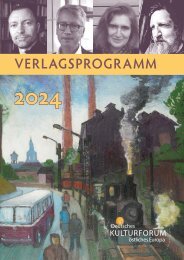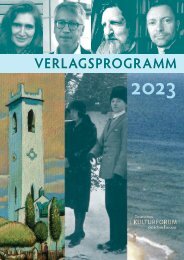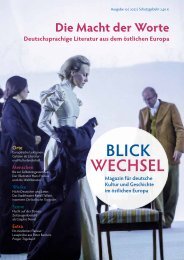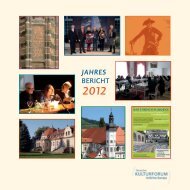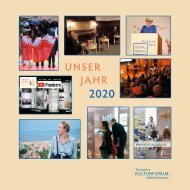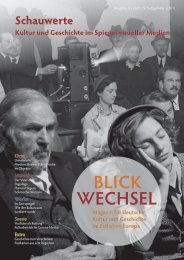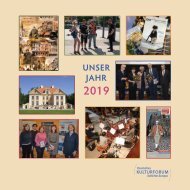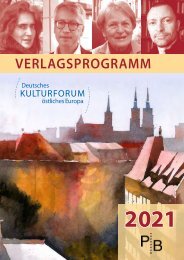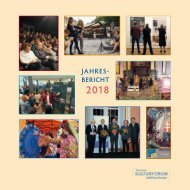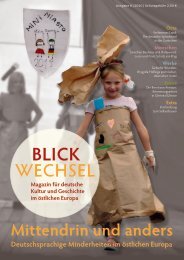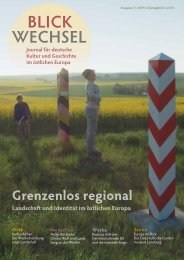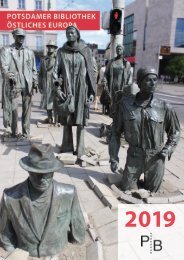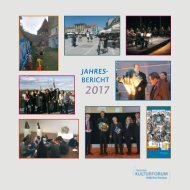Franz Xaver Gebel: Doppelquintett op. 28 | Carl Schuberth: Oktett op. 23
Ersteinspielung auf CD durch das Hoffmeister-Quartett mit Patrick Sepec und Solisten des Wrocław Baroque-Orchestra. Erschienen im Mai 2018
Ersteinspielung auf CD durch das Hoffmeister-Quartett mit Patrick Sepec und Solisten des Wrocław Baroque-Orchestra. Erschienen im Mai 2018
Sie wollen auch ein ePaper? Erhöhen Sie die Reichweite Ihrer Titel.
YUMPU macht aus Druck-PDFs automatisch weboptimierte ePaper, die Google liebt.
PH17071.Booklet.<strong>Gebel</strong> .qxp_PH?????_Booklet_Gamben/Handel 04.03.18 10:36 Seite 2<br />
© Sabine Wild
PH17071.Booklet.<strong>Gebel</strong> .qxp_PH?????_Booklet_Gamben/Handel 04.03.18 10:36 Seite 4<br />
World Premiere Recording<br />
F. X. <strong>Gebel</strong> & C. <strong>Schuberth</strong><br />
Streicherkammermusik<br />
in großer Besetzung<br />
aus Moskau und St. Petersburg<br />
Streicherkammermusik in großer Besetzung<br />
hat in Russland eine gewisse Tradition.<br />
<strong>Oktett</strong>e haben Nikolaj Afanasjew<br />
(1860er Jahre), Reinhold Glière (1903)<br />
und Dmitrij Schostakowitsch (1920er<br />
Jahre) geschrieben, wobei sie sich auf<br />
die deutsche Tradition seit Louis Spohrs<br />
D<strong>op</strong>pelquartetten (1824-1826) und Felix<br />
Mendelssohn-Bartholdys genialem <strong>Oktett</strong><br />
<strong>op</strong>. 20 (1825) bezogen. Von der Musikgeschichte<br />
vergessen wurden die beiden<br />
Werke, die auf dieser Compact-Disc wieder<br />
erklingen, und die beide in Russland<br />
entstanden. <strong>Franz</strong> <strong>Xaver</strong> <strong>Gebel</strong> (1787–<br />
1843) schrieb sein <strong>D<strong>op</strong>pelquintett</strong> in seinen<br />
letzten Lebensjahren in Moskau. Das<br />
Streichoktett von <strong>Carl</strong> <strong>Schuberth</strong> (1811–<br />
1863) entstand wenig später, ebenfalls in<br />
den 1840er Jahren in St. Petersburg, wo<br />
<strong>Schuberth</strong> als Violoncello-Virtuose und<br />
Dirigent wirkte.<br />
<strong>Franz</strong> <strong>Xaver</strong> <strong>Gebel</strong> wurde 1787 in Fürstenau<br />
(poln. Milin) bei Breslau geboren und<br />
erhielt seine musikalische Ausbildung wie<br />
viele seiner schlesischen Landsleute in<br />
Wien. Als seine Lehrer werden der Abbé<br />
Vogler und Johann Georg Albrechtsberger<br />
genannt. Nach verschiedenen Tätigkeiten<br />
als Kapellmeister in Wien, Pest, Hermannstadt<br />
(Sibiu) und Lemberg gelangte er<br />
schließlich 1817 nach Moskau, wo er für<br />
den Rest seines Lebens blieb und als Privatlehrer<br />
Klavier- und Kompositionsunterricht<br />
gab. Zu seinen berühmten Schülern zählten<br />
neben jungen Philos<strong>op</strong>hen und Literaten<br />
wie Nikolaj Stankewitsch und Nikolaj<br />
Ogarjow auch Persönlichkeiten, die für<br />
das spätere Musikleben in Moskau von<br />
großer Bedeutung waren: Der Schriftsteller<br />
und Musikkritiker Nikolaj Melgunow und<br />
der Pianist Alexander Villoing, der ab<br />
1837 als Lehrer des jungen Anton Rubinstein<br />
wirkte und als Begründer der russischen<br />
Pianistenschule gelten kann. Von<br />
<strong>Gebel</strong>s Moskauer Kompositionen wurden<br />
in seinen letzten Lebensjahren sieben<br />
Streichquintette und ein Streichquartett in<br />
Moskau gedruckt. Außerdem erschien<br />
auch eine Kompositionslehre aus seiner Feder<br />
in russischer Übersetzung – das erste<br />
Lehrbuch der musikalischen Komposition<br />
in russischer Sprache! Eine umfassende<br />
Würdigung der Verdienste <strong>Gebel</strong>s um die<br />
Moskauer Musikkultur finden wir in dem<br />
Nachruf eines anonymen Moskauer Korrespondenten<br />
in der Leipziger Allgemeinen<br />
musikalischen Zeitung vom <strong>23</strong>. Juni 1843.<br />
Über den „beliebten und geachteten Componisten<br />
und Clavierspieler“ heißt es hier:<br />
„<strong>Gebel</strong> ist aus Breslau gebürtig, hat hier<br />
[d.i. in Moskau] seit 35 Jahren gelebt und<br />
rastlos für den bessern Musikgeschmack<br />
gewirkt. Als Clavierspieler und Theoretiker<br />
gab er in den besten Häusern Unterricht<br />
zu 10 Rubel die Stunde und war als Meister<br />
seiner Kunst hochgeschätzt. Er lebte, wie<br />
jeder wahre Künstler, mehr für den Himmel<br />
als für die Erde. Das Geld war ihm nicht<br />
sein Gott. Wenn ihn ein poetischer Gedanke<br />
überraschte, da vergass er oft<br />
wochenlang zu unterrichten; er setzte sich<br />
an seinen Schreibtisch, um seine Gedanken<br />
zu Papier zu bringen […]. Vor einem<br />
erlesenen Kreise von Kunstkennern und<br />
Kunstliebhabern gab er früher, auf Subskription,<br />
in den Wintermonaten einen<br />
Cyclus von seinen, auch andrer Meister,<br />
Arbeiten: Quartette und Quintette, und gewährte<br />
auf diese Weise dem andächtigen<br />
Hörer manchen schönen Genuss, indem er<br />
dadurch den Sinn für das wahrhaft<br />
Schöne aufregte. Die Theilnehmer dieser<br />
Soiréen erinnern sich dieser angenehmen<br />
Stunden mit Vergnügen.“<br />
An <strong>Gebel</strong>s erwähnten Kammermusikabenden<br />
„auf Subskription“ (also mit verkauften<br />
Eintrittskarten), die als die ersten öffentlichen<br />
Kammerkonzerte in Moskau gelten<br />
dürften, erklangen anspruchsvolle Werke<br />
u.a. von Ludwig van Beethoven, aber<br />
auch Quartette und Quintette von <strong>Gebel</strong><br />
selbst. Die <strong>Gebel</strong>schen Kompositionen<br />
machten offenbar großen Eindruck auf<br />
seine Zeitgenossen. Fast zwanzig Jahr<br />
nach <strong>Gebel</strong>s Tod erschienen im Jahr 1862<br />
im Leipziger Verlag von Julius <strong>Schuberth</strong><br />
noch das Streichquintett Nr. 8 sowie das<br />
<strong>D<strong>op</strong>pelquintett</strong> <strong>op</strong>. <strong>28</strong>. <strong>Gebel</strong> hatte als<br />
Schöpfer von acht Streichquintetten die<br />
instrumentalen Möglichkeiten dieser besonderen<br />
Kammerbesetzung mit zwei<br />
Violoncelli bereits umfassend erforscht. In<br />
4<br />
5
PH17071.Booklet.<strong>Gebel</strong> .qxp_PH?????_Booklet_Gamben/Handel 04.03.18 10:36 Seite 6<br />
World Premiere Recording<br />
F. X. <strong>Gebel</strong> & C. <strong>Schuberth</strong><br />
seinem Opus <strong>28</strong> nutzt er die verd<strong>op</strong>pelte<br />
Besetzung zu sehr ausdifferenzierten<br />
Klangeffekten, indem er die zehn zur Verfügung<br />
stehenden Stimmen in den vielfältigsten<br />
Kombinationen einsetzt. Bei aller Intimität<br />
der kammer¬musikalischen Faktur<br />
ergeben instrumentatorische Kunstgriffe<br />
wie Pizzicato-Stellen, Tremoli sowie monumentale<br />
Unisono-Passagen bisweilen fast<br />
orchestrale Effekte. Melodisch einfallsreich<br />
ist bereits der erste Satz mit seinen kontrastierenden<br />
Themen und einem effektvollen<br />
eingeschobenen Choral der vier Celli. Der<br />
lyrische langsame Satz stellt zarte Kantilenen<br />
der Violoncelli gespenstischen Episoden<br />
und gesanglichen Passagen des Tutti<br />
gegenüber. Das ruppige Scherzo wird<br />
durch ein wunderschönes Mittelstück unterbrochen,<br />
in dem wiederum die vier Celli<br />
eine tragende Rolle spielen. Das nahezu<br />
sinfonische Finale beginnt in einer rezitativischen<br />
Introduktion, und es schließt sich<br />
ein dramatisches Allegro an, dessen<br />
stürmisches Moll-Thema einem lyrischen<br />
pizzicato-begleiteten Dur-Motiv gegenübergestellt<br />
ist und schließlich in einer rauschenden<br />
Koda endet.<br />
<strong>Carl</strong> <strong>Schuberth</strong> wurde 1811 in Magdeburg<br />
geboren und machte eine glänzende<br />
Karriere als Virtuose auf dem Violoncello.<br />
Seine Biografie ist recht ausführlich in dem<br />
Musikalischen Hand-Conversations-Lexicon<br />
seines älteren Bruders, Julius <strong>Schuberth</strong>,<br />
beschrieben, der in seinem Verlag auch<br />
eine Reihe von Kompositionen <strong>Carl</strong>s veröffentlichte.<br />
Dem biografischen Artikel entnehmen<br />
wir, dass <strong>Carl</strong> <strong>Schuberth</strong> sich<br />
nach ausgedehnten Konzertreisen durch<br />
ganz Eur<strong>op</strong>a Anfang der 1840er Jahre in<br />
St. Petersburg niederließ und dort „Musikdirector<br />
der Universität war, die kaiserliche<br />
Hofkapelle als Dirigent leitete, und<br />
zugleich als Music-Inspector der kaiserlichen<br />
Hoftheater-Anstalt fungirte.“ Er starb<br />
während eines Erholungsurlaubs im Jahre<br />
1863 in Zürich. Ob <strong>Schuberth</strong> in Russland<br />
noch dem Moskauer Kollegen <strong>Franz</strong> <strong>Xaver</strong><br />
<strong>Gebel</strong> begegnet war, ist nicht bekannt.<br />
Wir können jedoch davon ausgehen, dass<br />
<strong>Schuberth</strong> die Kompositionen des älteren<br />
Moskauer Kollegen kannte, sowohl die<br />
gedruckten als auch weitere in Abschriften<br />
verbreitete Werke. Vielleicht war es <strong>Carl</strong><br />
<strong>Schuberth</strong>, der <strong>Gebel</strong>s Achtes Quintett<br />
<strong>op</strong>. 27 und das <strong>D<strong>op</strong>pelquintett</strong> <strong>op</strong>. <strong>28</strong><br />
nach Deutschland mitnahm und seinem<br />
Bruder Julius für dessen Verlag empfahl.<br />
<strong>Carl</strong> <strong>Schuberth</strong>s <strong>Oktett</strong> <strong>op</strong>. <strong>23</strong> wurde<br />
1848 im Verlag Julius <strong>Schuberth</strong> in Leipzig<br />
gedruckt. Das viersätzige Werk beginnt<br />
mit einem ausgedehnten Allegro in leuchtendem<br />
E-Dur. Von besonderem Charme ist<br />
der Andante überschriebene zweite Satz<br />
in A-Dur mit seinen liedhaften Violoncello-<br />
Kantilenen. Das Scherzo ist ein schwungvoller<br />
Ländler mit einem gefühlvollen<br />
Mittelteil, in dem ein Wiener Volkston<br />
angeschlagen wird. Das abschließende<br />
Rondo ist Allegro furioso überschrieben<br />
und fordert in zweimal gesteigertem<br />
Tempo den acht Streichern große technische<br />
Virtuosität ab, bis es in einer Stretta<br />
prestissimo endet.<br />
6 7
PH17071.Booklet.<strong>Gebel</strong> .qxp_PH?????_Booklet_Gamben/Handel 04.03.18 10:36 Seite 8<br />
World Premiere Recording<br />
F. X. <strong>Gebel</strong> & C. <strong>Schuberth</strong><br />
Large-scale string chamber music<br />
from Moscow and St Petersburg<br />
There is a certain tradition of large-scale<br />
string chamber music in Russia. Octets<br />
were written by Nikolai Afanasjev (in the<br />
1860s), Reinhold Glière (1903) and<br />
Dmitri Shostakovich (1920s), which drew<br />
on the German tradition dating back to<br />
the Double Quartets by Louis Spohr<br />
(1824-1826) and Felix Mendelssohn<br />
Bartholdy’s inspired Octet <strong>op</strong>. 20 (1825).<br />
The two works on this compact disc, both<br />
originating in Russia, had been forgotten<br />
by musical history but can now be heard<br />
again. <strong>Franz</strong> <strong>Xaver</strong> <strong>Gebel</strong> (1787-1843)<br />
wrote his Double Quintet during the last<br />
years of his life in Moscow. The String<br />
Octet by <strong>Carl</strong> <strong>Schuberth</strong> (1811-1863)<br />
was written some time later, in the 1840s<br />
in St Petersburg, where <strong>Schuberth</strong> was<br />
active as a cello virtuoso and conductor.<br />
<strong>Franz</strong> <strong>Xaver</strong> <strong>Gebel</strong> was born in Fürstenau<br />
(Milin) near Breslau (Wrocław) in 1787<br />
and received his musical education in<br />
Vienna, as did many of his Silesian peers.<br />
His list of teachers included Abbé Vogler<br />
and Johann Georg Albrechtsberger. In<br />
Vienna, <strong>Gebel</strong> was engaged at first as the<br />
director of music at the Theater in Le<strong>op</strong>oldstadt<br />
and published some compositions.<br />
After working as a director of music in<br />
Vienna, Pest, Hermannstadt (Sibiu), and<br />
Lemberg (now Lviv in Western Ukraine),<br />
he ended up in Moscow in 1817, where<br />
he spent the rest of his life and gave private<br />
lessons for piano and composition.<br />
Some of his famous students included<br />
young philos<strong>op</strong>hers and literati like Nikolai<br />
Stankevich and Nikolai Ogaryov, and<br />
other individuals who were significant for<br />
the later musical culture in Moscow: The<br />
author and music critic Nikolai Melgunow<br />
and the pianist Alexander Villoing, who<br />
was engaged as a teacher to the young<br />
Anton Rubinstein from 1837 and can be<br />
considered the founder of the Russian<br />
school for pianists. Of the pieces <strong>Gebel</strong><br />
composed in Moscow, seven string quintets<br />
and one string quartet were printed in<br />
his last years in Moscow. Also a Russian<br />
translation of his composition studies was<br />
published – this was the first textbook on<br />
musical composition in Russian! We can<br />
find considerable appreciation of <strong>Gebel</strong>’s<br />
merits for the Moscow musical culture in<br />
the obituary by the anonymous Muscovite<br />
correspondent in the Leipzig Allgemeine<br />
musikalische Zeitung from June <strong>23</strong>, 1843.<br />
The “adored and respected composer and<br />
pianist” was eulogized there as follows:<br />
“<strong>Gebel</strong> was born in Breslau and lived<br />
here [in Moscow] for 35 years, in ceaseless<br />
dedication to improving musical<br />
tastes. As a pianist and theorist, he taught<br />
for 10 rubles an hour in the best homes<br />
and was highly esteemed as a master of<br />
his art. He lived - as every true artist - more<br />
for heaven than for earth. He did not<br />
worship money. If a poetic thought surprised<br />
him, he often forgot for weeks to<br />
give his lessons and sat at his desk putting<br />
his thoughts onto paper […]. Earlier, a<br />
select circle of art connoisseurs and art<br />
lovers, who purchased season tickets<br />
during the winter, were treated to a cycle<br />
including <strong>Gebel</strong>’s own work and that of<br />
other masters. These performances were<br />
composed of quartet and quintets and<br />
moved audiences into rapt awe by transporting<br />
them with truly beautiful pieces.<br />
Participants in these soirées look back on<br />
those occasions with great pleasure.”<br />
Subscribers to <strong>Gebel</strong>’s evenings of chamber<br />
music had purchased tickets to what<br />
was probably the first public chamber<br />
concerts in Moscow, where they heard<br />
s<strong>op</strong>histicated pieces by Ludwig van Beethoven,<br />
and also quartets and quintets by<br />
<strong>Gebel</strong> himself. <strong>Gebel</strong>’s compositions<br />
apparently made quite an impression on<br />
his contemporaries. Almost 20 years after<br />
<strong>Gebel</strong>’s death, the String Quintet No. 8<br />
and the Double Quintet Op. <strong>28</strong> were<br />
published at the Julius <strong>Schuberth</strong> publishing<br />
house in Leipzig in 1862. Having<br />
produced eight string quintets, <strong>Gebel</strong> had<br />
already extensively explored the possibility<br />
of extending this particular chamber combination<br />
with two cellos. In his Opus <strong>28</strong><br />
he used this doubled line-up for clearly<br />
differentiated sound effects, in which he<br />
8 9
PH17071.Booklet.<strong>Gebel</strong> .qxp_PH?????_Booklet_Gamben/Handel 04.03.18 10:36 Seite 10<br />
World Premiere Recording<br />
F. X. <strong>Gebel</strong> & C. <strong>Schuberth</strong><br />
made use of the ten available voice-lines<br />
in a wide variety of combinations. With all<br />
the intimacy available in chamber music<br />
structures, almost symphonic orchestral<br />
effects can be produced through such instrumental<br />
devices as pizzicato sections,<br />
tremoli, and monumental passages in unison.<br />
The <strong>op</strong>ening movement demonstrates<br />
musical inventiveness right from the start<br />
with its contrasting themes and an effectively<br />
interpolated chorale on the four<br />
cellos. This extended slow movement is<br />
almost in the form of an <strong>op</strong>eratic scene:<br />
the lyrical arioso of the violins is interrupted<br />
by a hymn on the cellos and violas.<br />
Dramatic, occasionally ghost-like interventions<br />
and instrumental recitatives indicate<br />
a stimulating devel<strong>op</strong>ment between the<br />
numerous voices that are involved, which<br />
finally returns to the uniting theme of the<br />
arioso song. The energetic and somewhat<br />
rough Scherzo is interrupted by a beautiful<br />
hymn-like central section in D major, in<br />
which the four cellos again play a key<br />
role. The Finale begins with a recitativelike<br />
introduction, in which the first cello<br />
engages as it were in a conversation with<br />
the other instruments in the ensemble. It is<br />
followed by a dramatic Allegro, where a<br />
stormy minor theme is juxtaposed with a<br />
lyrical major motif with pizzicato accompaniment.<br />
The devel<strong>op</strong>ment is interrupted<br />
several times by a chorale-like episode,<br />
following a plaintive recitative over a ghostly<br />
tremolo bass-line. The double quintet finally<br />
comes to an end in a rousing apotheosis.<br />
<strong>Carl</strong> <strong>Schuberth</strong> was born in Magdeburg in<br />
1811 and had a glittering career as a virtuoso<br />
cellist. His biography is extensively<br />
described in the Musikalisches Conversations-Lexicon<br />
of his older brother, Julius<br />
<strong>Schuberth</strong>, whose publishing house also<br />
published a series of <strong>Carl</strong>’s compositions.<br />
From the biographical article we learn that<br />
after extensive concert tours throughout the<br />
whole of Eur<strong>op</strong>e, <strong>Carl</strong> <strong>Schuberth</strong> settled in<br />
St Petersburg at the beginning of the 1840s<br />
where he “was Music Director at the University,<br />
led the imperial court orchestra as its<br />
conductor and served at the same time as<br />
music inspector of the imperial court theatre.”<br />
He died in Zurich in 1863 whilst on rest<br />
leave. Whether <strong>Schuberth</strong> ever met his<br />
Moscow colleague <strong>Franz</strong> <strong>Xaver</strong> <strong>Gebel</strong> whilst<br />
he was in Russia is not known. But we can<br />
be sure that <strong>Schuberth</strong> would have known<br />
the compositions of his older Moscow<br />
colleague, both the works that were in print<br />
as well as others that were distributed in<br />
manuscript. It may even have been <strong>Carl</strong><br />
<strong>Schuberth</strong> who took <strong>Gebel</strong>’s Eighth Quintet<br />
<strong>op</strong>.27 and the Double Quintet <strong>op</strong>.<strong>28</strong> with him<br />
to Germany and recommended it to his brother<br />
Julius for printing by his publishing house.<br />
<strong>Carl</strong> <strong>Schuberth</strong>’s Octet <strong>op</strong>.<strong>23</strong> was printed<br />
in Leipzig by Julius <strong>Schuberth</strong>’s publishing<br />
house in 1848. The four movement work<br />
begins with an extended Allegro in a bright<br />
E major. The second movement in A major<br />
headed Andante is particularly charming<br />
with its song-like cello cantilena. The<br />
Scherzo is a jolly rustic Ländler with a<br />
lyrical central section, the slow waltz-tempo<br />
of which is reminiscent of the atmosphere in<br />
a Viennese Coffee House. The festively<br />
boisterous Rondo of the Finale has the<br />
heading Allegro furioso and demands great<br />
technical virtuosity of the eight instrumentalists<br />
playing at double speed, culminating<br />
in a prestissimo closing stretta.<br />
10 11
PH17071.Booklet.<strong>Gebel</strong> .qxp_PH?????_Booklet_Gamben/Handel 04.03.18 10:36 Seite 12<br />
World Premiere Recording<br />
F. X. <strong>Gebel</strong> & C. <strong>Schuberth</strong><br />
Das Hoffmeister-Quartett wurde im Jahr<br />
2002 mit dem Ziel gegründet, die Streichquartette<br />
der Klassik und Frühromantik in<br />
ihrer kaum erschlossenen Vielfalt wiederzuentdecken<br />
und im Klang ihrer Zeit aufzuführen.<br />
Benannt nach <strong>Franz</strong> Anton Hoffmeister,<br />
dem Zeitgenossen, Freund und<br />
Kollegen von Mozart und Haydn, nimmt<br />
das Ensemble neben berühmten Werken<br />
Haydns, Mozarts und Beethovens immer<br />
auch Streichquartette der zahlreichen<br />
weniger bekannten Meister ihrer Zeit in<br />
seine Programme auf. In der Profil Edition<br />
Günter Hänssler erschien die vielbeachtete<br />
Gesamtaufnahme der zwölf Streichquartette<br />
des St. Petersburger „genialen Sonderlings“<br />
Anton Ferdinand Titz sowie die<br />
Aufnahmen der beiden Streichquartette<br />
und des Achten Streichquintetts von <strong>Franz</strong><br />
<strong>Xaver</strong> <strong>Gebel</strong>. Beteiligt war das Hoffmeister-Quartett<br />
auch bei der CD-Einspielung<br />
der Kammermusik E.T.A. Hoffmanns<br />
für die Profil-Edition.<br />
Am ersten Pult des Hoffmeister-Quartetts<br />
wechseln sich die in Hannover ansässigen<br />
Geiger Ulla Bundies und Christ<strong>op</strong>h<br />
Heidemann ab, aus Berlin kommen die<br />
Bratschistin Aino Hildebrand und der Cellist<br />
Martin Seemann. Sie alle musizieren<br />
auch in renommierten deutschen Ensembles<br />
wie Cantus Cölln, Akademie für Alte<br />
Musik Berlin, Concerto Brandenburg, Concerto<br />
Köln, Lautten Compagney und Musica<br />
Alta Ripa. Konzertreisen führten das<br />
Hoffmeister-Quartett bisher nach Belgien<br />
und in die Niederlande, nach Polen, Russland<br />
und in die Ukraine sowie nach Japan.<br />
In der Aufnahme des <strong>D<strong>op</strong>pelquintett</strong>s von<br />
<strong>Franz</strong> <strong>Xaver</strong> <strong>Gebel</strong> wird das Hoffmeister-<br />
Quartett durch Patrick Sepec am zweiten<br />
Violoncello verstärkt. Patrick Sepec<br />
erhielt seine Violoncello-Ausbildung an der<br />
Baseler Musikhochschule sowie an der<br />
Schola Cantorum Basiliensis. Er arbeitet<br />
regelmäßig mit international renommierten<br />
Ensembles mit dem Barockcello als auch<br />
mit der Gambe.<br />
Hoffmeister Quartet & Patrick Sepec<br />
© Sabine Wild<br />
12 13
PH17071.Booklet.<strong>Gebel</strong> .qxp_PH?????_Booklet_Gamben/Handel 04.03.18 10:36 Seite 14<br />
World Premiere Recording<br />
F. X. <strong>Gebel</strong> & C. <strong>Schuberth</strong><br />
The Hoffmeister Quartet was founded in<br />
2002 with the goal of rediscovering string<br />
quartets from the Classic and Early Romantic<br />
periods in their nearly untapped<br />
complexity and of performing this music<br />
as it would have sounded at the time it<br />
was written. Named for <strong>Franz</strong> Anton Hoffmeister<br />
– the contemporary, friend, and<br />
colleague of Mozart and Haydn – the ensemble<br />
always also includes string quartets<br />
in its programs from numerous and<br />
less well known masters of their time next<br />
to famous pieces by Haydn, Mozart, and<br />
Beethoven. The Profil Edition Günter<br />
Hänssler showcased the highly acclaimed<br />
complete recordings of the 12 string<br />
quartets by the ingenious eccentric from<br />
St. Petersburg, Anton Ferdinand Titz and<br />
recently the recording of both string<br />
quartets and the Eighth String Quintet from<br />
<strong>Franz</strong> <strong>Xaver</strong> <strong>Gebel</strong>. The Hoffmeister<br />
Quartet also participated in the CD recordings<br />
of the chamber music by E.T.A.<br />
Hoffmann for the Profil Edition.<br />
Ulla Bundies and Christ<strong>op</strong>h Heidemann,<br />
who both live in Hanover, alternate as the<br />
first violinist of the Hoffmeister Quartet.<br />
The violist Aino Hildebrand and the cellist<br />
Martin Seemann both come from Berlin.<br />
They all also play in prestigious German<br />
ensembles, like the Akademie für Alte<br />
Musik Berlin, Cantus Cölln, Concerto<br />
Brandenburg, Concerto Köln, Lautten<br />
Compagney, and Musica Alta Ripa. Concert<br />
tours have taken the Hoffmeister<br />
Quartet to Belgium, the Netherlands,<br />
Poland, Russia, the Ukraine, and Japan.<br />
In the recording of the String Quintet from<br />
<strong>Franz</strong> <strong>Xaver</strong> <strong>Gebel</strong>, the Hoffmeister Quartet<br />
is supported by Patrick Sepec on<br />
second violoncello. Patrick Sepec received<br />
his cello training at the Basel Music<br />
College and also at the Schola Cantorum<br />
Basiliensis. He works regularly with internationally<br />
renowned ensembles, both on<br />
the baroque cello and also on the viola da<br />
gamba.<br />
Das Wrocław Baroque Orchestra wurde<br />
im Jahr 2006 gegründet und ist fester<br />
Bestandteil des Nationalen Forums für<br />
Musik Breslau/Wrocław (NFM), einer der<br />
bedeutendsten Musikinstitutionen Polens.<br />
Das Repertoire umfasst Werke der Instrumentalmusik<br />
ebenso wie große Oratorien,<br />
von der Barockzeit bis zur Romantik.<br />
Künstlerischer Leiter des Orchesters ist seit<br />
seiner Gründung der namhafte Violoncellist<br />
Jarosław Thiel. Das Solistenensemble,<br />
das von den Konzertmeistern des<br />
Orchesters gebildet wird, tritt in verschiedenen<br />
Besetzungen auf und hat bereits<br />
zahlreiche Meisterwerke des 19. Jahrhunderts<br />
auf historischen Instrumenten interpretiert.<br />
Das Nationale Forum der Musik<br />
(NFM) in Wrocław ist ein sehr<br />
modernes Konzerthaus, das<br />
über vier Säle mit hervorragender Akustik<br />
verfügt, darunter der Hauptkonzertsaal für<br />
1800 Zuschauer. Das NFM ist zugleich<br />
eine moderne Kultureinrichtung, die sich<br />
zum Ziel setzt, sowohl die Bewohner als<br />
auch die Besucher von Wrocław zur akti-<br />
ven Teilnahme an dessen lebendigen Kulturleben<br />
anzuspornen. Zurzeit initiiert das<br />
NFM acht internationale Ereignisse (wie<br />
das Internationale Festival Wratislavia<br />
Cantans), zu denen jedes Jahr angesehene<br />
Musiker und Ensembles aus Polen<br />
und der ganzen Welt eingeladen werden.<br />
Das Gebäude selbst wird zum Raum für<br />
Begegnungen von Vertretern unterschiedlicher<br />
Künste. Das NFM koordiniert folgende<br />
elf Künstlerensembles: das NFM Symphonieorchester,<br />
das NFM Le<strong>op</strong>oldinum-<br />
Kammerorchester, das Barockorchester<br />
Wrocław, den NFM Chor, den NFM<br />
Jugendchor, das Lutosławski Quartet, das<br />
LutosAir Quintet, das NFM Ensemble, das<br />
NFM Streichtrio Le<strong>op</strong>oldinum, das Polish<br />
Cello Quartet und das Wrocław Baroque<br />
Ensemble. Die Musikproduktionen des<br />
Nationalen Forums der Musik bieten jedes<br />
Jahr neue CDs in verschiedenen Stilrichtungen.<br />
Das NFM engagiert sich darüber<br />
hinaus in vielfältigen Bildungsmaßnahmen.<br />
Andrzej Kosendiak, einer der Begründer<br />
des Nationalen Forums der Musik, ist derzeit<br />
sein Direktor.<br />
14<br />
15
PH17071.Booklet.<strong>Gebel</strong> .qxp_PH?????_Booklet_Gamben/Handel 04.03.18 10:36 Seite 16<br />
World Premiere Recording<br />
F. X. <strong>Gebel</strong> & C. <strong>Schuberth</strong><br />
© Łukasz Rajchert<br />
Wrocław Baroque Orchestra<br />
The Wrocław Baroque Orchestra was<br />
founded in 2006 and is a permanent<br />
component of the National Forum for<br />
Music in Breslau/Wrocław (NFM), one of<br />
the most significant music institutions in<br />
Poland. Its repertoire includes instrumental<br />
works as well as large-scale oratorios,<br />
from the baroque to the romantic period.<br />
The artistic director of the orchestra ever<br />
since its foundation has been the<br />
renowned cellist Jaroslav Thiel. The<br />
ensemble of soloists, made up of the lead<br />
players of the orchestra, appear in various<br />
combinations and have already performed<br />
numerous masterworks of the 19th<br />
century on historical instruments.<br />
The National Forum of Music in<br />
Wrocław is a state-of-the-art concert<br />
venue, including, among<br />
others, four concert halls, with the main<br />
hall seating 1800 pe<strong>op</strong>le. The four auditoriums<br />
can boast of excellent acoustics. The<br />
NFM is also a progressive performing arts<br />
organisation whose aim is to pr<strong>op</strong>agate<br />
active participation in cultural life among<br />
Wrocław citizens and visitors to the city.<br />
The intensive educational and promotional<br />
activities have resulted in eight festivals<br />
being presented by the NFM (including<br />
the Andrzej Markowski International Festival<br />
Wratis-lavia Cantans), each year<br />
hosting the most outstanding Polish and<br />
international artists. The venue itself has<br />
become a meeting place for various<br />
artistic genres, not only musical. The NFM<br />
is home to 11 resident ensembles: NFM<br />
Wrocław Philharmonic, NFM Le<strong>op</strong>oldinum<br />
Orchestra, Wrocław Baroque Orchestra,<br />
NFM Choir, NFM Boys’ Choir,<br />
Lutosławski Quartet, LutosAir Quintet,<br />
NFM Ensemble, NFM Le<strong>op</strong>oldinum String<br />
Trio, Polish Cello Quartet, and Wrocław<br />
Baroque Ensemble. The National Forum of<br />
Music’s recording catalogue continues to<br />
grow, and each year sees the release of<br />
several new CDs with versatile repertoire.<br />
A gamut of educational activities is<br />
addressed to all age groups. Andrzej<br />
Kosendiak, now serving as NFM Director,<br />
is one of the founding fathers of the NFM.<br />
16<br />
17
PH17071.Booklet.<strong>Gebel</strong> .qxp_PH?????_Booklet_Gamben/Handel 04.03.18 10:36 Seite 18<br />
© Joanna Stoga
PH17071.Booklet.<strong>Gebel</strong> .qxp_PH?????_Booklet_Gamben/Handel 04.03.18 10:36 Seite 20<br />
Recording: 2017, Andreaskirche Berlin-Wannsee<br />
Co<strong>op</strong>eration Deutschlandfunk Kultur & Deutsches Kulturforum östliches Eur<strong>op</strong>a<br />
Producer: Stefan Lang, Klaus Harer<br />
Recording producer and digital editing: Uwe Walter, Dipl. Tonmeister VDT<br />
Programme Notes: Klaus Harer<br />
Translation: Sheila Brain<br />
Cover Foto: Sabine Wild, Berlin<br />
Graphic arts: Birgit Fauseweh<br />
Profil<br />
Edition<br />
Günter<br />
Hänssler<br />
2017 by<br />
and<br />
2018 by Profil Medien GmbH<br />
info@haensslerprofil.de, www.haensslerprofil.de<br />
Manufactured in Austria<br />
PH17071




